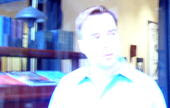From today's issue of City Beat:
( Thank You so much for this, Katie! )
Editorial
Paper Moon
BY Katie Laur | Posted 11/07/2007
Carteaux and Leslie, a fine used book store just a few doors from the corner of Vine and Court streets, is presenting an exhibition called Rensler's Revisited: A Fresh Look at Vintage Works From a Venerable Cincinnati Portrait Studio. I hadn't noticed when I moved here to Court Street that the elegant book store, with its front door set back from the sidewalk, was the same store I visited in 1980 with author John Baskin, but when the old photographs went up on the most recent Final Friday, the memories came flooding back to me.
During those years, when Baskin and I went about together, he interviewed the owner of the shop, June Rensler, for a book called Prairie Fires and Paper Moons, published by David Godine Publishers. He's granted me access to his notes from that long-ago interview.
June's father opened the shop in 1906. A lot of immigrants, fresh to the city, wanted postcard portrait photos to mail home, and June noted they seldom smiled.
"Did they think it made them more intelligent?" she asked herself.
Baskin had a different conclusion. He thought it more likely that people didn't smile because the exposure times were long. "Hard to hold a smile for half a minute without it turning into a rictus," he said.
Photography had only begun to appear during the Civil War, and June said her father had been influenced by field reports of a younger brother who ran away from home to work with a traveling photographer.
And so the Rensler shop coincided with this international epidemic in picture postcards.
Her father lived on bananas (5 cents a dozen at a little market up the street) and couldn't afford all the supplies he needed. When customers lined up on the sidewalk, an assistant collected the money from everyone and then ran out and bought film.
For 25 years he never had a key to the front door because he was open 24 hours a day, ignoring the blue laws that said he was supposed to be closed on Sundays.
On Sundays, his assistants ran the shop. When they were arrested, Rensler came downtown and bailed them out; the fine was cheaper than losing the day's proceeds. He did this until the laws changed.
"I wore them out," he told June, satisfied.
Halloween was a great night for the shop, although it frightened June, this young girl looking at nearby Over-the-Rhine, the costumed adults festively roaming the byways and alleys -- sort of an extended gallery hop, and probably not a lot different than today if everyone were disguised as a beggar. Sometimes she locked herself in the car.
The same customers came back again and again. June remembers one old German from the neighborhood who came in every weekend. "Mama, no flowers tonight," he said, handing Rensler the last of his money.
The photo backdrops were done by itinerant painters who were always a little drunk -- pale men who worked at night and, like elves, finished in the early morning hours and were never seen again.
According to June, the patrons were infatuated with the moon. They sang to it, counted the days until it was full again and wanted their pictures taken with it, so her grandfather made one. It was a great sickle of a moon with a face on it, and the customers loved it.
If you're too young to remember paper moons, the movie with Tatum O'Neal or the song, you might remember the scene in Sweet and Lowdown, a Woody Allen movie, where an eccentric Jazz guitarist, played by Sean Penn, tries to perform on a paper moon. Rensler's customers had their pictures taken over and over on it until "the luster wore off of it," June says.
Rensler taught June the trade, but he would never allow her to have one of the newer box cameras "the little people use." Photography was a respected craft to him, and he was treated respectfully. "Like a doctor," he said.
"Go back and look at the Rembrandts," he told June. "Study the lighting. Photography is all lighting. It is the play of light on a flat surface that gives the illusion of the third dimension. You must have shadows."
He thought that in 20 years he had made a half a million prints. He built a new house and told his family it was made of postcards. The business lasted until World War II, and after that time so many things changed.
When John Baskin found the shop in 1980, Rensler's portrait was in the window, one of the few he had allowed of himself. He wore a hat and a topcoat and held his cigar at a jaunty angle.
June was still making postcards, only she used a piece of developing paper and cut it into the correct size. By the time Baskin found her, the moon had worn out.
KATIE LAUR's column appears here the first issue of each month.
Wednesday, November 7, 2007
Subscribe to:
Post Comments (Atom)


No comments:
Post a Comment